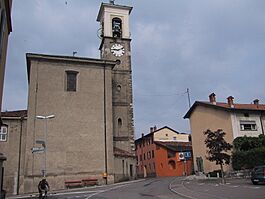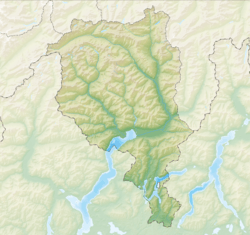Ligornetto facts for kids
Quick facts for kids
Ligornetto
|
||
|---|---|---|
 |
||
|
||
| Country | Switzerland | |
| Canton | Ticino | |
| District | Mendrisio | |
| Area | ||
| • Total | 2.02 km2 (0.78 sq mi) | |
| Elevation | 362 m (1,188 ft) | |
| Population
(Dec 2011)
|
||
| • Total | 1,716 | |
| • Density | 849.5/km2 (2,200/sq mi) | |
| Postal code |
6853
|
|
| Surrounded by | Besazio, Clivio (IT-VA), Genestrerio, Rancate, Stabio | |
Ligornetto was once a separate town, or municipality, in Switzerland. It was located in the canton of Ticino, which is a region in southern Switzerland.
In 2013, Ligornetto joined with a few other nearby towns, Besazio and Meride. They all became part of the larger town of Mendrisio.
Contents
History of Ligornetto
Ligornetto is a very old place! It was first mentioned in official papers way back in the year 789. Back then, it was called Logurno.
We know people lived here even before that. There are signs from the Roman times (a very long time ago!) that show Ligornetto has been home to people for centuries. The village is mentioned in old documents from the 8th, 9th, 12th, and 13th centuries. These papers often talked about farms and land owned by different groups in a city called Como. By 1254, Ligornetto was already known as its own municipality.
Originally, Ligornetto was part of a larger church area called the Pieve of Balerna. But in 1557, it became its own independent parish, which means it had its own main church and priest. The main church, called San Lorenzo, has been around since the 1200s. It was rebuilt and updated in the 1700s. There's also a smaller church building, or Oratory, dedicated to St. Joseph. It was first mentioned in 844 and was originally named after St. Maria.
A famous Swiss sculptor named Vincenzo Vela was born in Ligornetto. After he passed away, he left many of his artworks and belongings to his hometown. Because of his gift, a museum dedicated to his work opened in Ligornetto in 1898.
For a long time, Ligornetto was a small farming village. People mostly grew grains and grapes for wine. They also raised silkworms and got stone from a local quarry. Many people from Ligornetto also traveled to other places for work, often as plasterers or masons, and then returned home. In more recent years, the village has changed a lot. More factories and businesses have moved in, and more people who work across the nearby border with Italy have come to live there. This has led to the building of many new homes.
Geography of Ligornetto
Before it joined Mendrisio, Ligornetto covered an area of about 2 square kilometers (about 0.77 square miles).
A big part of this land, almost 59%, was used for farming. This means fields for crops, orchards, and vineyards. About 22% of the land was covered in forests. The remaining land was used for buildings, roads, and other developed areas (about 35.6%). A small part, about 1.5%, was unproductive land, like rocky areas.
Within the developed areas, about 18% was for homes and other buildings. Roads and transportation took up about 10%. There were also areas for industrial buildings, power, water, and parks.
Ligornetto is located in the Mendrisio district, very close to the border with Italy.
Coat of Arms
The blazon (official description) of Ligornetto's coat of arms is: "Per bend gules and azure a bend argent between two corn ears or." This means the shield is divided diagonally. One part is red (gules) and the other is blue (azure). There's a silver (argent) band going across the middle, with two golden (or) corn ears on either side.
People of Ligornetto
In 2011, Ligornetto had about 1,716 people living there. About 15% of the people living in Ligornetto in 2008 were from other countries. Over ten years (from 1997 to 2007), the number of people living in Ligornetto grew by about 18%.
Most people in Ligornetto speak Italian, which is the main language in the Ticino canton. About 90% of the population spoke Italian in 2000. Other languages spoken included German (5%) and French (2.3%).
In 2008, there were slightly more women (50.9%) than men (49.1%) living in Ligornetto. The population also saw more births than deaths in 2008, leading to a small increase in the number of Swiss citizens. The number of people from other countries also increased due to people moving to Ligornetto.
The age groups in Ligornetto in 2009 showed that about 10% of the population were children aged 0-9, and 11% were teenagers aged 10-19. The largest group was adults between 40 and 49 years old, making up about 18% of the population. There were also many older adults, with about 22% of the population being 60 years or older.
Most homes in Ligornetto in 2000 were single-family houses (about 67%). There were also many apartment buildings. The most common apartment size had four rooms. Most apartments were lived in all year round.
The chart below shows how the population of Ligornetto has changed over many years:

Important Heritage Sites
The Museo Vincenzo Vela is a very important place in Ligornetto. It is listed as a Swiss heritage site of national significance. This means it's considered a really important cultural treasure for the whole country. The entire village of Ligornetto is also listed in the Inventory of Swiss Heritage Sites, showing its historical and cultural value.
Economy and Jobs
In 2007, the unemployment rate in Ligornetto was about 3.17%. This means a small percentage of people who wanted to work couldn't find a job.
In 2005, there were different types of jobs in Ligornetto:
- Primary sector: About 56 people worked in farming, which is the primary sector.
- Secondary sector: About 265 people worked in the secondary sector, which includes manufacturing (making things in factories) and construction (building things).
- Tertiary sector: About 201 people worked in the tertiary sector, which includes services like shops, restaurants, and offices.
In 2008, there were 426 full-time jobs in Ligornetto. Most of these jobs were in manufacturing (making products) and construction. Many other jobs were in services, like sales, transportation, hotels, and healthcare.
Ligornetto is a place where more people come to work than leave for work. In 2000, about 645 workers came into Ligornetto for their jobs, while 534 workers left Ligornetto to work elsewhere. Many of the people who came to work in Ligornetto were from outside Switzerland. Most people (about 74%) used a private car to get to work, while a smaller number (about 5%) used public transportation.
Religion
Based on a census from 2000, most people in Ligornetto were Roman Catholic (about 83%). A smaller group (about 4.6%) belonged to the Swiss Reformed Church. Some people belonged to other churches, and a few did not state their religion.
Education
Switzerland is known for having a well-educated population. In Ligornetto, about 74% of adults aged 25-64 had completed either high school or even higher education, like university.
In 2009, there were 305 students in Ligornetto. The education system in Ticino, where Ligornetto is located, offers different levels of schooling:
- Kindergarten: There were 44 children in kindergarten, which is not required but helps young children prepare for school.
- Primary School: This program lasts for five years. In Ligornetto, 105 students attended regular primary schools, and a few attended special schools.
- Lower Secondary School: After primary school, students can choose different paths. Some go to a two-year middle school, followed by a pre-apprenticeship. Others go to a four-year program to prepare for university.
- Upper Secondary School: This level prepares students for a trade job or for university. Students can attend school full-time or part-time while also doing an internship or apprenticeship.
- Professional Program: This three-year program prepares students for specific jobs in fields like engineering, nursing, or business.
In 2000, only a few students from Ligornetto went to school in other towns. However, many students from Ligornetto (124 of them) traveled to schools outside the municipality.
See also
 In Spanish: Ligornetto para niños
In Spanish: Ligornetto para niños







